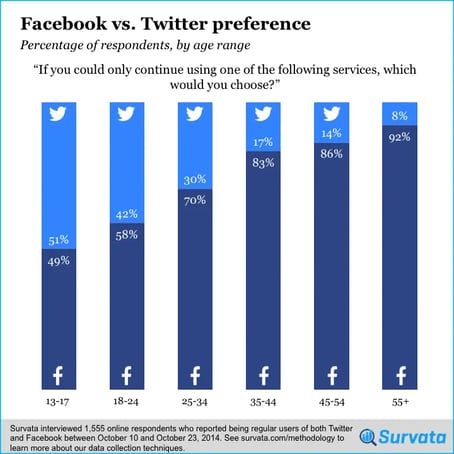Facebook vs Twitter: Understanding the Key Differences and Impact
Introduction
The idea that social media are defined simply by their ability to bring people together has been seen as too broad, as this would suggest that fundamentally different technologies like the telegraph and telephone are also social media.[29] The terminology is unclear, with some early researchers referring to social media as social networks or social networking services in the mid-2000s.[7] A more recent paper from 2015 reviewed the prominent literature in the area and identified four common features unique to then-current social media services:[2]
- Web 2.0 Internet-based applications.[2][5]
- User-generated content[2][5]
- User-created self profiles[2][7]
- Social network formed by connections between profiles,[2][7] such as followers or groups
In the realm of social media, Facebook and Twitter stand as titans, each boasting billions of users and influencing global conversations. While both platforms serve as mediums for connecting people and sharing content, they diverge significantly in their functionality, user demographics, and impact on society. Understanding the differences between Facebook and Twitter is crucial for users, businesses, and policymakers alike, as it shapes how information is disseminated, discussions unfold, and communities form online
Functionality and Features
At their core, Facebook and Twitter serve as platforms for social networking, but their functionalities vary considerably.
Facebook: Launched in 2004, Facebook initially focused on connecting college students. Over the years, it evolved into a comprehensive social networking site, allowing users to create profiles, share posts, photos, and videos, join groups, and follow pages. The algorithm-driven news feed customizes content based on user preferences, past interactions, and engagement levels. Facebook emphasizes personal connections, encouraging users to connect with friends and family, making it a hub for personal updates, life events, and sharing memories.
Twitter: In contrast, Twitter, founded in 2006, adopts a microblogging format, limiting posts to 280 characters (formerly 140 characters). It facilitates real-time conversations, news dissemination, and networking through tweets, retweets, hashtags, and mentions. Twitter's design promotes brevity, making it ideal for quick updates, breaking news, and trending topics. Its open nature allows users to follow anyone, regardless of mutual connections, fostering a more public and diverse discourse compared to Facebook's friend-centric model.

User Demographics
Understanding the demographics of Facebook and Twitter users sheds light on their respective impacts and influence on society.
Facebook: Historically, Facebook has attracted a broad user base spanning various age groups, with a significant presence among older demographics. According to Pew Research Center, in 2021, around 69% of U.S. adults reported using Facebook, making it one of the most widely used social media platforms. Facebook's appeal lies in its ability to connect people with their existing social circles, making it a preferred platform for maintaining relationships and sharing personal content.
Twitter: Twitter, on the other hand, tends to attract a younger audience and professionals seeking real-time updates and networking opportunities. Pew Research Center data indicates that about 23% of U.S. adults use Twitter, with a higher concentration among younger adults aged 18-29. Twitter's user base is characterized by its active engagement in current events, discussions on social issues, and interaction with public figures, journalists, and influencers.
Impact on Society and Culture
The influence of Facebook and Twitter extends beyond individual interactions, shaping societal norms, political discourse, and cultural trends.
Facebook: With its vast user base and personalized news feed, Facebook has faced scrutiny over its role in disseminating misinformation, echo chambers, and algorithmic amplification of divisive content. The platform's targeted advertising capabilities have raised concerns about privacy and data security, prompting debates on regulatory oversight and ethical practices. Despite these challenges, Facebook remains a dominant force in digital marketing, business promotion, and community building.
Twitter: Twitter's real-time nature has made it a catalyst for social movements, activism, and public awareness campaigns. Hashtags like #BlackLivesMatter, #MeToo, and #BringBackOurGirls have gained momentum on Twitter, amplifying marginalized voices and mobilizing communities for social change. However, Twitter's open environment also makes it susceptible to abuse, harassment, and the spread of hate speech, prompting calls for stronger moderation and content regulation.
Conclusion
In the ongoing Facebook vs Twitter debate, understanding the distinct roles and impacts of each platform is essential. While Facebook prioritizes personal connections and curated content, Twitter fosters public discourse and real-time engagement. Both platforms have revolutionized how we communicate, share information, and connect with others, but they also face challenges related to privacy, misinformation, and online safety. As users navigate the complexities of social media, critical awareness of these differences empowers individuals to make informed choices about their online presence and participation in digital communities.
References
- ^ Jump up to:
- a b Kietzmann, Jan H.; Hermkens, Kristopher (2011). "Social media? Get serious! Understanding the functional building blocks of social media". Business Horizons (Submitted manuscript). 54 (3): 241–251. doi:10.1016/j.bushor.2011.01.005. S2CID 51682132.
- ^ Jump up to:
- a b c d e f g h i j k l Obar, Jonathan A.; Wildman, Steve (2015). "Social media definition and the governance challenge: An introduction to the special issue". Telecommunications Policy. 39 (9): 745–750. doi:10.2139/ssrn.2647377. SSRN 2647377.
- ^ Tuten, Tracy L.; Solomon, Michael R. (2018). Social media.marketing. Los Angeles: Sage. p. 4. ISBN 978-1-5264-2387-0.
- ^ Jump up to:
- a b c Aichner, T.; Grünfelder, M.; Maurer, O.; Jegeni, D. (2021). "Twenty-Five Years of Social Media: A Review of Social Media Applications and Definitions from 1994 to 2019". Cyberpsychology, Behavior, and Social Networking. 24 (4): 215–222. doi:10.1089/cyber.2020.0134. PMC 8064945. PMID 33847527.
- ^ Jump up to:





























